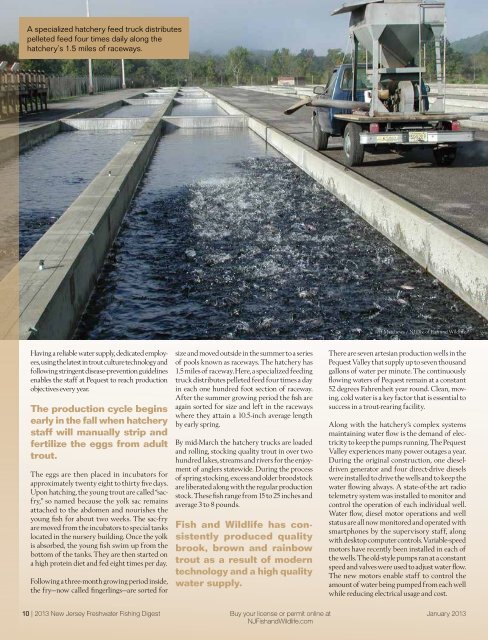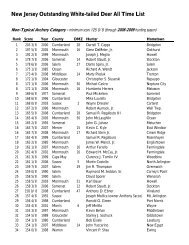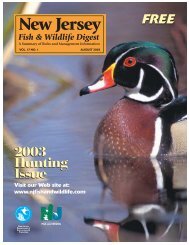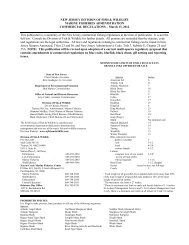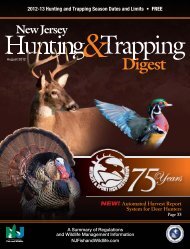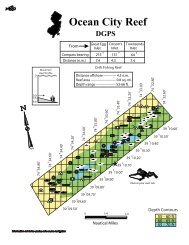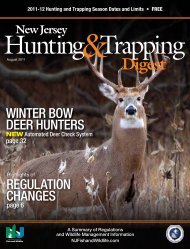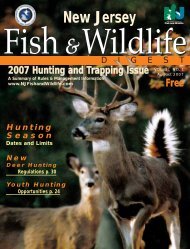Complete 2013 Freshwater Fishing DIGEST - State of New Jersey
Complete 2013 Freshwater Fishing DIGEST - State of New Jersey
Complete 2013 Freshwater Fishing DIGEST - State of New Jersey
- No tags were found...
Create successful ePaper yourself
Turn your PDF publications into a flip-book with our unique Google optimized e-Paper software.
A specialized hatchery feed truck distributespelleted feed four times daily along thehatchery’s 1.5 miles <strong>of</strong> raceways.Jeff Matthews / NJ Div. <strong>of</strong> Fish and WildlifeHaving a reliable water supply, dedicated employees,using the latest in trout culture technology andfollowing stringent disease-prevention guidelinesenables the staff at Pequest to reach productionobjectives every year.The production cycle beginsearly in the fall when hatcherystaff will manually strip andfertilize the eggs from adulttrout.The eggs are then placed in incubators forapproximately twenty eight to thirty five days.Upon hatching, the young trout are called “sacfry,”so named because the yolk sac remainsattached to the abdomen and nourishes theyoung fish for about two weeks. The sac-fryare moved from the incubators to special tankslocated in the nursery building. Once the yolkis absorbed, the young fish swim up from thebottom <strong>of</strong> the tanks. They are then started ona high protein diet and fed eight times per day.Following a three-month growing period inside,the fry—now called fingerlings—are sorted forsize and moved outside in the summer to a series<strong>of</strong> pools known as raceways. The hatchery has1.5 miles <strong>of</strong> raceway. Here, a specialized feedingtruck distributes pelleted feed four times a dayin each one hundred foot section <strong>of</strong> raceway.After the summer growing period the fish areagain sorted for size and left in the racewayswhere they attain a 10.5-inch average lengthby early spring.By mid-March the hatchery trucks are loadedand rolling, stocking quality trout in over twohundred lakes, streams and rivers for the enjoyment<strong>of</strong> anglers statewide. During the process<strong>of</strong> spring stocking, excess and older broodstockare liberated along with the regular productionstock. These fish range from 15 to 25 inches andaverage 3 to 8 pounds.Fish and Wildlife has consistentlyproduced qualitybrook, brown and rainbowtrout as a result <strong>of</strong> moderntechnology and a high qualitywater supply.There are seven artesian production wells in thePequest Valley that supply up to seven thousandgallons <strong>of</strong> water per minute. The continuouslyflowing waters <strong>of</strong> Pequest remain at a constant52 degrees Fahrenheit year round. Clean, moving,cold water is a key factor that is essential tosuccess in a trout-rearing facility.Along with the hatchery’s complex systemsmaintaining water flow is the demand <strong>of</strong> electricityto keep the pumps running. The PequestValley experiences many power outages a year.During the original construction, one dieseldrivengenerator and four direct-drive dieselswere installed to drive the wells and to keep thewater flowing always. A state-<strong>of</strong>-the art radiotelemetry system was installed to monitor andcontrol the operation <strong>of</strong> each individual well.Water flow, diesel motor operations and wellstatus are all now monitored and operated withsmartphones by the supervisory staff, alongwith desktop computer controls. Variable-speedmotors have recently been installed in each <strong>of</strong>the wells. The old-style pumps ran at a constantspeed and valves were used to adjust water flow.The new motors enable staff to control theamount <strong>of</strong> water being pumped from each wellwhile reducing electrical usage and cost.10 | <strong>2013</strong> <strong>New</strong> <strong>Jersey</strong> <strong>Freshwater</strong> <strong>Fishing</strong> Digest Buy your license or permit online at January <strong>2013</strong>NJFishandWildlife.com


